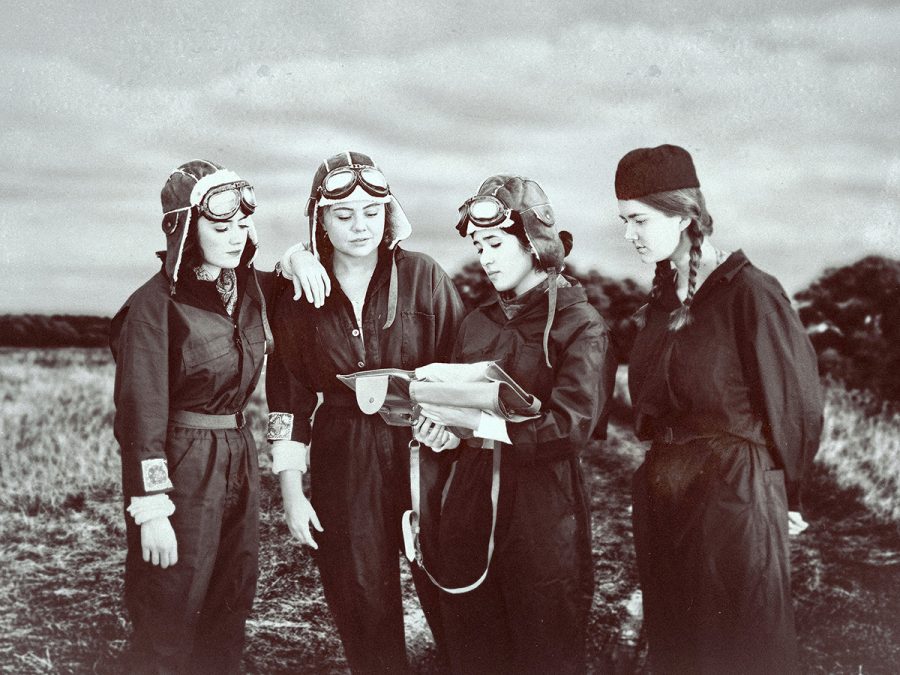U Theatre Thrives with Virtual Production of “The Night Witches”
November 21, 2020
In spite of the changes to daily life that the COVID-19 pandemic has brought, the University of Utah’s theatre department has found a way to keep the arts and theatre alive through an entirely virtual production of “The Night Witches.”
Written by local Salt Lake playwright Rachel Bublitz and directed by Alexandra Harbold — an assistant professor in the theatre department — “The Night Witches” tells the story of oft-forgotten Russian female fighter pilots.
A Brief History Lesson
During World War II, the Soviet Air Force created a night bomber regiment for the women who wanted to help fight against the Germans. Although they were ill-equipped and forced to build planes out of wood and canvas, the 588th Night Bomber Regiment played a key role in continuing to bomb the Germans during the night — ensuring that they would not be able to sleep. The Soviet army was not initially welcoming to this all-female aviation team, and their regiment was left with minimal materials. There was not enough material available to build planes out of metal. Furthermore, the women were only supplied with hand-me-down uniforms, over-sized shoes and rudimentary tools — but most significantly, these planes went up into the air without parachutes for the pilot and navigator. Any crash would be a death sentence for these volunteer fighters.
Within the regiment, when women would volunteer to help the Soviet army, they would start out as mechanics, then they would slowly move up the ranks to become navigators, pilots and commanders — even if they wanted to stay at one rung of this ladder. But still, the 588th Night Bomber Regiment — with improper materials and a lack of resources — was able to complete over 23,000 missions, all without a radio or parachute, and this regiment became the most decorated unit in the Soviet Air Force.
Theatre Survives and Thrives Online
Bublitz’s play opens on Nina and Vera, two mechanics who have just finished their training to serve as navigators. “The Night Witches” follows the course of one night as these two characters embark on their first night as mechanics and join the ranks of their fellow navigators and pilots.
Without radios or advanced technology, the role of the navigator was vital to ensure the pilot would be targeting the right area for the bombs. These bombs were pushed out by hand, and many of these navigators and pilots were all too aware that they were risking their lives in order to fight for the Soviet Union.
As Nina (Chessie Hseih) and Vera (Lina Boyer) visualize the night ahead of them, they can only fear for the worst as they have yet to understand the severity of taking off into the night in a plane made from scraps.
The production of “The Night Witches” was presented entirely virtually with all of the performances happening live. Initially, I was a bit hesitant about the virtual production — after all, it seems like everyone struggles with the ability to focus or pay attention in Zoom classes. But, I was pleasantly surprised to see just how successful the virtual play was. Each of the characters in the regiment were so dynamic and complex that you wanted and needed to pay attention in order to fully grasp the gravity of their situation. Instead of a tiled Zoom screen, the producers, scenic designers and media designers — Sydney Cheek-O’Donnell, Ariana Hatch, Abish Noble and Gavin Yehle — were able to transport the audience through their computer screen.
At times, the entire 15-person cast was all “on-stage” or “on-screen,” but for different scenes, there were monologues with one person alone and enlarged on the screen. The cast also creatively portrayed the dialogue scenes with the screen split between their two faces, with characters that appeared to be looking directly at one another.
The most successful element of the play, however, was the use of props. The characters all carried the bags and embroidery that the Soviet women would have with them in order to pass the time. Frequently, the actors were seen working on their embroidery projects to transport the scene to 1940s Russia. But, when the planes took off, the play truly began to feel like an immersive experience. The actors had planks of wood and other materials to frame their bodies in the planes, and other actors stood on-screen and supplemented some of the plane movements to showcase the different aspects of their night flight. Whereas an in-person play might rely on a creative or unique backdrop, these actors were all set against a black backdrop. Attention was focused on each of the individuals, but through the use of props, it was easy to forget that they were all separated. With carefully coordinated movements and bridges between different portions of the screen, the play came to life.
The Value of Virtual Platforms
While we might all wish to spend time away from screens in this age of online classes and working from home, the virtual production of “The Night Witches” blew me away. I did not expect to be so enthralled and consumed with the play, but it is easily my favorite virtual adaptation of the in-person events I’ve been missing. Even though there were a few technical difficulties and some elements that didn’t quite translate to the online format — some of the songs and moments where actors would speak at the same time or attempt to speak over each other didn’t quite work with the virtual platform — the play completely redefined what a virtual production looks like. It was clearly performed live, but the addition of closed captioning was a wonderful inclusion to make the experience more accessible to all.
Overall, I was shocked at just how much I enjoyed this virtual experience. The play taught me about a key group of women in the Russian army that I had never heard about before, and my breath was taken away by just how creative the play’s producers were in translating this performance to an online platform. During this pandemic, it is easy to feel discouraged at the state of the world. However, the U’s production of “The Night Witches” easily showcased just how creative storytellers have become. No matter what the world throws at us, we will still have the arts which will continue to unite us. Just as the pilots bravely took off into the dark night, we can similarly come together in a virtual space to overcome the isolation and loneliness that the pandemic has brought.













Biswapriya Purkayastha • Dec 30, 2020 at 5:47 am
It is absolutely untrue that the Night Witches built planes out of canvas and wood because metal wasn’t available. They flew old Polikarpov 2 biplane crop dusters made of plywood and canvas from the 1920s converted into makeshift bombers. It’s also not true that any crash was a death sentence; the Po 2 was so light and stable that crew members repeatedly walked away from crashes unscathed. Hero Of The Soviet Union and Colonel Nadezhda Popova (852 missions, 18 of them in a single night), for instance, met her future husband while hitching a ride back to her airfield with a Red Army motorised column after being shot down on one of numerous occasions.